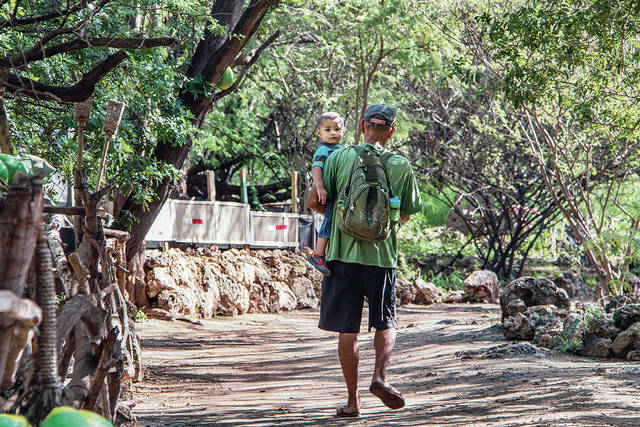Bill would prevent sweep of Waianae homeless camp

DENNIS ODA / DODA@STARADVERTISER.COM
A resident of Pu‘uhonua o Waianae holds a child while walking through the homeless encampment by the Waianae Small Boat Harbor.
In response to growing concerns about one of the state’s largest homeless encampments — Pu‘uhonua o Waianae, next to the Waianae Small Boat Harbor — several state representatives want a new law that would protect the occupants from getting swept off the state-owned land.
“It’s a big one,” said Rep. John Mizuno, chairman of the House Health and Human Services Committee, which is scheduled to hear HB 2754 Wednesday morning. “It’s a bill that has a lot of heart for the homeless. … We want to give them a little bit of time to transition out.”
Mizuno expects that a ban on enforcing criminal trespass laws for Pu‘uhonua o Waianae would have a specific end date, although none is identified in the bill, which states, “The purpose of this act is to exempt the land where the homeless community of Pu‘uhonua O Waianae currently exists from the offense of criminal trespass onto state lands.”
The bill comes amid changing views about Pu‘uhonua o Waianae, which was once considered a potential model for how government-sanctioned “safe zones” could look across a state that continues to struggle with the highest per capita rate of homelessness in the country.
Pu‘uhonua o Waianae has won praise for, among other things, emphasizing education for the homeless children in the encampment while relying on homeless volunteers to enforce rules that call for banishment for violations.
But officials with the state Department of Land and Natural Resources, which owns the 19.5-acre parcel below Pu‘uhonua o Waianae as well as the Waianae Small Boat Harbor next door, are trying to figure out what to do about skyrocketing water use at the harbor, along with concerns about hygiene, trash and potential destruction of cultural and natural resources within the encampment blamed on both humans and their dogs.
Don't miss out on what's happening!
Stay in touch with breaking news, as it happens, conveniently in your email inbox. It's FREE!
“The tide’s been changing just a little bit,” Mizuno said.
DLNR officials are considering recommending proposals for Pu‘uhonua o Waianae that could come before the Board of Land and Natural Resources as soon as next month.
A recent report to the Legislature said the population of Pu‘uhonua o Waianae has ranged from a low of 170 people to a high of 319.
“In general, the administration is looking at ways to better manage state lands,” said Scott Morishige, the state’s homeless coordinator, “and DLNR has been assessing the situation at Pu‘uhonua o Waianae and is looking at bringing something up potentially before the Land Board.”
HB 2754 would eliminate a sweep of Pu‘uhonua o Waianae as a possible option for DLNR.
Mizuno, who co-authored the bill that was introduced by three other representatives, said it’s designed to give state and county officials time to find another location that works better for the residents of Pu‘uhonua o Waianae, although such a location could prove elusive.
Mizuno has spent more than a decade calling for the creation of safe zones for Hawaii’s homeless. He’s now re-branded the concept to call them “ohana zones,” which he said would have to include proper hygiene, water, security, social services and transportation for the occupants to get to and from work or school, along with allowing pets.
“The big problem was that we never did give an inclusive description of what a safe zone is,” Mizuno said.
Federal, state and city homeless officials have long been saying that safe zones don’t work, but merely distract from helping the homeless by spending time trying to figure out whose neighborhood would get a safe zone.
“I can’t get their minds off of safe zones being a tent city,” Mizuno said. “We agree that perhaps the people of that area need to have a transition plan in place — perhaps to an ohana zone with hygiene areas, restrooms, bathrooms. We’re not in defiance of the governor or the mayor, the city or the state. We’re just asking for a timeout while we carefully transition our people out of homelessness.”
The larger question remains, “How do we respectfully and reasonably transfer our people by the boat harbor out to an ohana zone and then to the endgame, getting them into affordable rental units?” Mizuno asked. “A sweep is not the answer.”
Morishige said there are no clear places that could accommodate dozens of people and their dogs from Pu‘uhonua o Waianae while ensuring drinking water, proper hygiene and security.
“There’s very limited state land available that has enough space to support a community of that size, as well as infrastructure,” Morishige said. “It’s an issue not just whether those things are in place, but also an issue of cost. That makes it very challenging.”
Tanya Tehotu, executive director of the Kealahou West Oahu nonprofit group, which provides social service outreach to Pu‘uhonua o Waianae, said the homeless occupants, in general, have become less willing to move out over time.
Homeless people living on the street tend to be more willing to move into a shelter “when they hit rock bottom,” Tehotu said.
But that’s not the case for most residents of Pu‘uhonua o Waianae.
“Maybe a few years ago” some homeless people in the encampment may have been willing to relocate to a shelter or even a permanent home, she said.
“It was more common before,” Tehotu said. “Now they’ve built their own community. They’re comfortable.”



